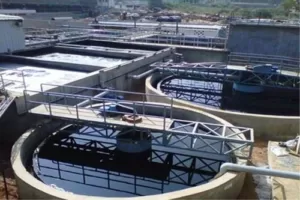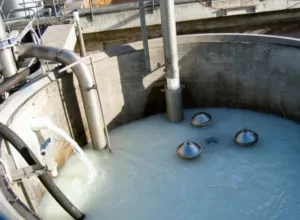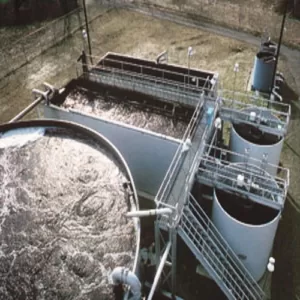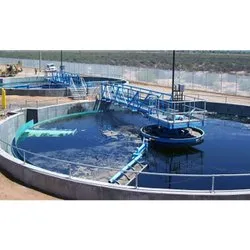
1.Effluent treatment plant Waterproofing – importance
Waterproofing the effluent treatment plant (ETP) is essential for several reasons, including:
- Protection of the environment: The effluent generated in the ETP may contain harmful pollutants that can contaminate the soil and water bodies if they leak from the plant. Waterproofing the ETP prevents any seepage or leakage of the effluent, protecting the environment from contamination.
- Compliance with regulations: Most countries have strict regulations regarding the discharge of industrial effluent into the environment. Waterproofing the ETP ensures that the effluent is properly contained and treated before discharge, helping companies to comply with these regulations.
- Prevention of equipment and tank damage: The tanks & equipment used in the ETP can be damaged by exposure to moisture or water. Waterproofing the ETP prevents water damage to the equipment, reducing the need for frequent repairs and replacements.
- Increased efficiency: Waterproofing the ETP can help to improve the efficiency of the treatment process by reducing the risk of leaks and ensuring that the effluent is properly contained and treated.
- Protection of workers: Effluent can contain harmful chemicals and pollutants that can be hazardous to human health. Waterproofing the ETP protects workers from exposure to these substances and ensures a safe working environment.
- Cost savings: Waterproofing the ETP can help to reduce maintenance costs by preventing water damage and the need for frequent repairs or replacements.
2. available system for Effluent treatment plant Waterproofing
There are several waterproofing systems available for effluent treatment plants (ETPs), including:
- Polyurethane coatings: Polyurethane coatings provide a durable and waterproof layer that can protect the concrete substrate of the ETP from water infiltration and chemical attack. They can be applied in a range of thicknesses and are suitable for both new and existing ETPs.
- Epoxy coatings: Epoxy coatings are a popular choice for ETP waterproofing as they provide excellent chemical and abrasion resistance. They are also resistant to UV radiation, making them suitable for outdoor applications.
- PVC liners: PVC liners are a cost-effective and durable option for ETP waterproofing. They are available in a range of thicknesses and can be custom-fabricated to fit the specific dimensions of the ETP.
- Bituminous membranes: Bituminous membranes are a popular choice for ETP waterproofing as they provide excellent chemical resistance and are highly durable. They are typically made from modified bitumen or synthetic rubber and can be applied using a torch or cold adhesive.
- Cementitious coatings: Cementitious coatings are a cost-effective and environmentally friendly option for ETP waterproofing. They are made from a mixture of cement and polymers and can be applied in a range of thicknesses.
- Two-component, polymer-modified cementitious membrane. The technology combines complementary chemistries that form a cross-linked interpenetrating network, enhancing the overall material properties. The resulting membrane has excellent chemical resistance and crack-bridging properties, making it ideal for the waterproofing and protection of concrete structures in harsh conditions.
It’s important to consult with a professional waterproofing contractor to determine the most suitable system for your ETP, based on factors such as the type of effluent, the location of the ETP, and the budget.



3. selection of Effluent treatment plant Waterproofing
Here are some factors to consider when selecting waterproofing for an effluent treatment plant:
- Chemical Resistance: Effluent treatment plants can contain a range of aggressive chemicals, including acids, alkalis, and hydrocarbons. It is important to choose a waterproofing system that is resistant to the specific chemicals present in your plant.
- Durability: Effluent treatment plants are typically subject to heavy use, with constant exposure to chemicals, water, and mechanical stress. Look for a waterproofing system that is durable enough to withstand this type of environment, and has a proven track record of long-term performance.
- Crack Bridging: Concrete structures are prone to cracking over time, which can compromise the integrity of the waterproofing system. A crack-bridging waterproofing system can help to prevent leaks by accommodating movement and bridging cracks.
- Application Method: The type of application method can affect the cost and speed of installation, as well as the overall quality of the waterproofing. For example, spray-applied systems can be faster to install, but may not be suitable for all surfaces or conditions.
- Environmental Impact: Consider the environmental impact of the waterproofing system, including its VOC content and potential for leaching into the surrounding soil or water.
- Manufacturer Support: Look for a waterproofing system from a reputable manufacturer that provides technical support and warranties for their products.
It is important to note that selecting the appropriate waterproofing system for an effluent treatment plant can be a complex process and should involve a professional waterproofing consultant or engineer with experience in this specific area. They can assess the site conditions, determine the potential exposure to chemicals and other factors, and recommend the most appropriate system to ensure effective and long-lasting waterproofing and protection.
GEOLIZ WATERPROOFERS PVT. LTD.
Waterproofing Products & Services Guide
For details on other waterproofing products & Services
